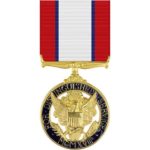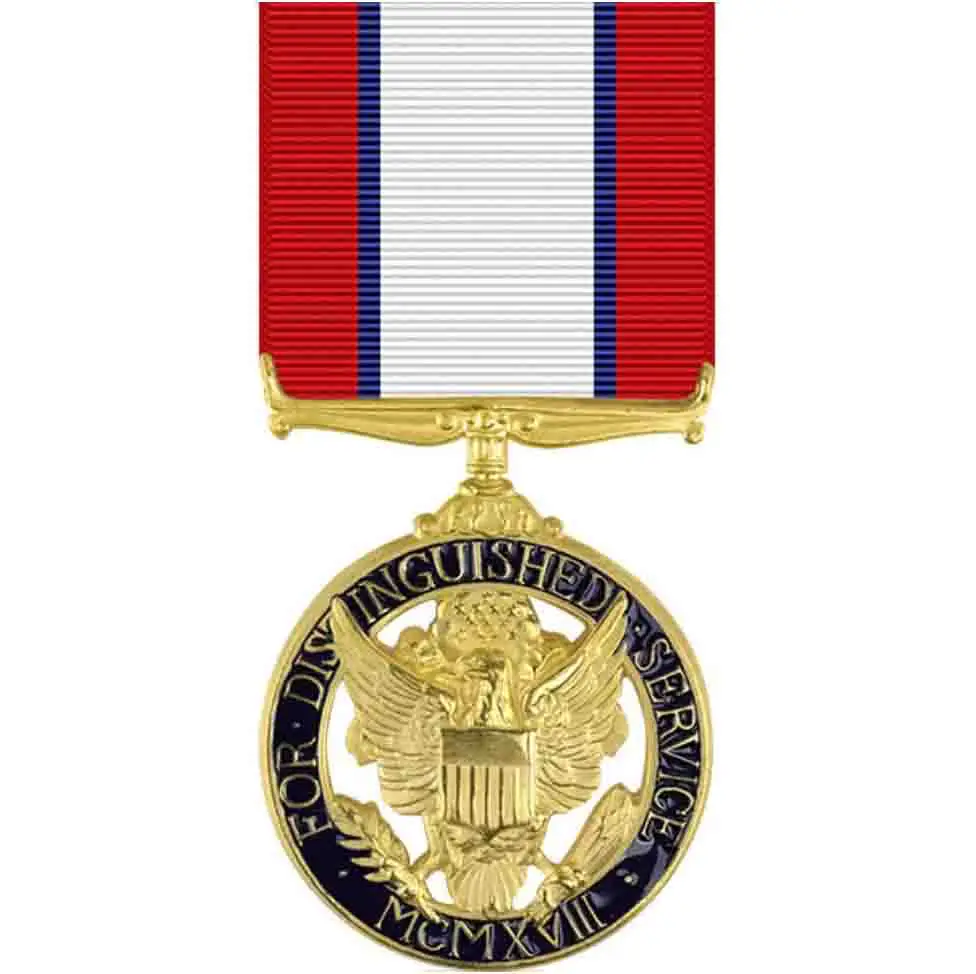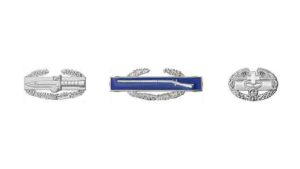The Distinguished Service Medal
 The Distinguished Service Medal was established by Act of Congress 9 July, 1918. An Act of Congress is a formal written enactment that legally commands something regarding the United States of America. Congress commanded the creation of the Distinguished Service Medal granting national recognition to the recipients of this medal.
The Distinguished Service Medal was established by Act of Congress 9 July, 1918. An Act of Congress is a formal written enactment that legally commands something regarding the United States of America. Congress commanded the creation of the Distinguished Service Medal granting national recognition to the recipients of this medal.
The general purpose of the award was to acknowledge the contributions of soldiers who, while serving in any capacity with the U.S. Army, has distinguished themselves by exceptionally meritorious service to the government in a duty of great responsibility. The policies regarding award of the Distinguished Service Medal along with the other awards granted to United States Army soldiers are prescribed in Army Regulation 600-8-22 while the wear and appearance are governed by Army Regulation 670-1.

Variations
There are separate Distinguished Service Medals designated for the different branches of the military as well. There is also a fifth version of the medal known as the “Defense Distinguished Service Medal” which is a senior award of the United States Department of Defense. The United States Army version of the Distinguished Service Medal is normally referred to simply as the “Distinguished Service Medal”, while the other branches of service use the service name as a prefix. The word “Defense” Distinguishes the higher award (Department of Defense level) from the others.

Background
The Distinguished Service Medal was actually authorized by Presidential Order on January 2, 1918. President Woodrow Wilson was the president at that time. It was confirmed by Congress on July 9, 1918. War Department General Order No. 6, January 12, 1918, announced the award with the following language:
“A bronze medal of appropriate design and a ribbon to be worn in lieu thereof, to be awarded by the President to any person who, while serving in any capacity with the Army shall hereafter distinguish himself or herself, or who, since April 6, 1917, has distinguished himself or herself by exceptionally meritorious service to the Government in a duty of great responsibility in time of war or in connection with military operations against an armed enemy of the United States.”
The Act of Congress recognized the need for differentiation of types and degrees of heroism and meritorious service. It also included the provisions and criteria required for the issuance of the award. The current statutory authorization for the Distinguished Service Medal is found in Title 10, United States Code, Section 3743.
The first awards of the Distinguished Service Medal were made for service in World War I Recipients included many of the Commanding Officers of the Allied Armies. Namely, individuals such as; Marshals Foch and Joffre, General Petain of France, Field Marshal Haig of Great Britain, General Diaz of Italy, General Gillain of Belgium, and General Pershing of the United States.
Requirements
Typically, the Distinguished Service Medal is awarded in time of war or in connection with military operations against an armed enemy of the United States. But, aside from that, there are other consideration;
- For service not related to actual war, the term “duty of great responsibility” applies to a narrower range of positions than in time of war and requires evidence of conspicuously significant achievement. However, justification of the award may accrue by virtue of exceptionally meritorious service in a succession of high positions of great importance.
- Awards may be made to persons other than Servicemembers of the Armed Forces of the United States for wartime services only, and then only under exceptional circumstances with the express approval of the President in each case.
Components Authorized for Issue
There are four components authorized for issue regarding the Distinguished Service Medal.
The following are authorized components of the Distinguished Service Medal:
- Medal
- Miniature Medal
- Ribbon
- Lapel Button
Appurtenances
Only certain appurtenances are authorized for wear with the Distinguished Service Medal.
The “C” Device is authorized.
The “C” device will only be awarded to indicate award was made for meritorious service or achievement under combat conditions occurring on or after January 7, 2016.
- Only one “C” device is worn to indicate initial award. The “C” device will be centered on the suspension ribbon if not worn with any other devices. Subsequent awards for meritorious service under combat conditions are indicated by oak-leaf clusters or Arabic numerals.
- The “C” device, when worn with Arabic Numerals or oak-leaf clusters, will be to the wearer’s right.
Arabic Numerals (Bronze or Gold) are authorized. When the “C” device is worn in combination with oak-leaf clusters and the total number of devices exceeds four, then Arabic numerals (bronze or gold) are worn in place of the oak-leaf clusters to indicate the number of subsequent awards.
Oak-Leaf Clusters (Bronze or Silver) are Authorized.
Oak-leaf clusters, 13/32 inches in length, are worn on the suspension and service ribbon of the medal with the stems of the leaves pointing to the wearer’s right to denote subsequent awards.
- A bronze oak-leaf cluster is worn to designate a subsequent award. No more than four bronze oak-leaf clusters may be worn.
- A silver oak-leaf cluster is worn in lieu of five bronze oak-leaf clusters. Silver oak-leaf clusters are worn to the wearer’s right of a bronze oak-leaf cluster.
- Oak-leaf clusters will be centered on the suspension ribbon when not worn with the “C” device.
- Oak-leaf clusters, when worn with the “C” device, will be to the wearer’s left and the devices will be evenly spaced on the suspension or service ribbon.
If the total number of devices exceeds four, then Arabic numerals will be used to indicate subsequent awards rather than oak-leaf clusters.
Silver oak-leaf clusters are not authorized with the “C” device. Use Arabic numerals to indicate subsequent awards rather than silver oak-leaf clusters.

Appearance

Medal Description
The front of the medal features the Coat of Arms of the United States in gold. The Coat Arms is surrounded by a circle of dark blue enamel. This surrounding enamel band is 1 1/2 inches in diameter. There is an inscription encircling the band that reads “FOR DISTINGUISHED SERVICE MCMXVIII”, the Roman Numeral MCMXVIII representing the year 1918 which is the year the medal was authorized for issue.
The back side of the medal features a scroll on which the name of the recipient is to be engraved. The scroll surmounts a trophy of flags and weapons.
The Distinguished Service Medal is suspended by a bar attached to the suspension ribbon. The suspension ribbon is red, white, and blue representing the colors of the United States Flag.
Ribbon

The ribbon for the Distinguished Service Medal is 1 3/8 inches wide and 3/8 inches in height. The face of the ribbon appears as five stripes which are from left to right as follows; a 5/16 inch red stripe (scarlet), a 1/16 inch wide blue stripe (ultramarine blue), a 5/8 inch wide white stripe (centered), another 1/16 inch blue stripe (ultramarine blue) and another 5/16 inch white red stripe (scarlet).
Order of Precedence
The distinguished Service Medal is classified under United States Army Individual Decorations
In order of precedence, the Distinguished Service Medal is worn after the Military Service Crosses (i.e. Distinguished Service Cross, Navy Cross, or Air Force Cross). The order of precedence for individual decorations is as follows;
Medal of Honor
Distinguished Service Cross
Distinguished Service Medal
Silver Star
Legion of Merit
Distinguished Flying Cross
Soldier’s Medal
Bronze Star Medal
Meritorious Service Medal
Air Medal
Army Commendation Medal
Army Achievement Medal
Check out the Military Art Collection!



